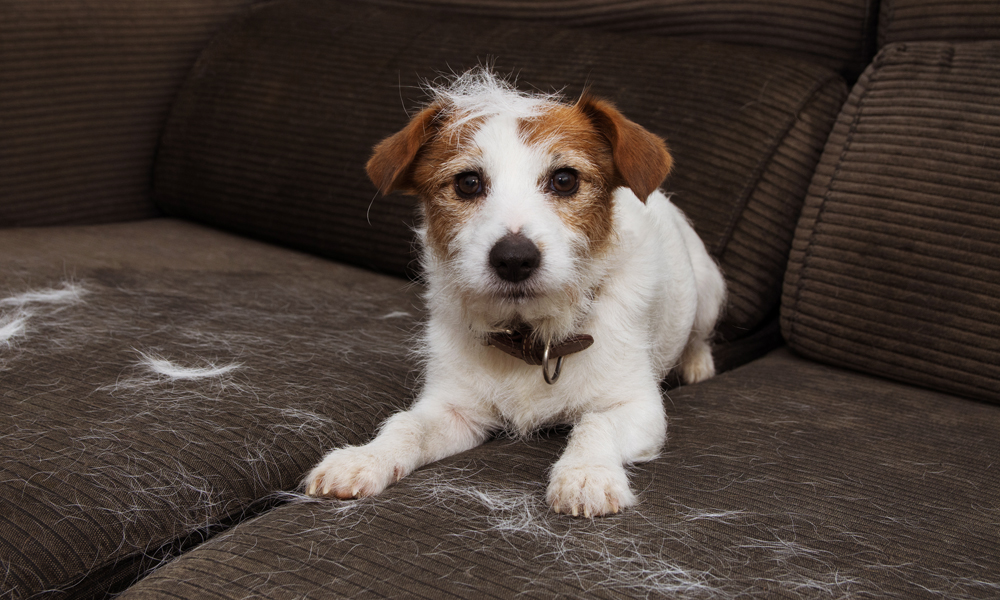Most pet owners enjoy the tactile sensation of running their hands over their pet’s soft, cuddly fur. In fact, studies show petting a cuddly animal can actively reduce stress.
That said, we’re generally not as enthusiastic about encountering their abundant fur once it’s fallen out, turned into a gazillion individual hairs and become attached to our furniture, our cars, our clothing or even our food.
Shedding is a normal and healthy part of a dog’s life, and it’s very common; in a recent health survey by animal research site Embarkvet.com, nearly half of the respondents said their dogs shed at least a moderate amount. Nevertheless, your dog’s shedding could be causing you headaches ranging from household messiness to clogged vacuums to heightened allergic reactions among family members.
Here’s a brief guide that may help you deal with the problem.
What’s going on? Potential reasons for copious shedding
It may seem to you that your dog is divesting itself of its hair in crazy amounts, but the fact is that many breeds are genetically inclined to shed a lot. Further, many shed all year round, particularly if they primarily live indoors. So how are you supposed to know what’s normal?
Shedding as a natural function
You may wish to start by refreshing yourself on the characteristics of your dog’s breed and the extent to which they traditionally shed. In healthy dogs, shedding is typically a natural way for your dog to rid itself of the old, unneeded and/or damaged hair that makes up its undercoat. Many breeds grow thicker coats as winter progresses, then lose them in the spring to better regulate their body temps. What surprises many pet owners is that sudden hot or cold spells at any time of the year can also kick that process into gear.
As a rule of thumb, your dog’s shedding is likely natural and healthy if it occurs uniformly all over the body and doesn’t create missing patches of fur. The most common times of the year for dogs to shed? In the spring, as he rids himself of excess insulation for the warmer weather, and in the fall as his new undercoat grows in (and pushes out the older hairs) to protect him from the cold.
Surprisingly, long-haired breeds are not necessarily the biggest shedders. Dogs that do shed most include Akitas, Siberian huskies, Bernese mountain dogs, Boston terriers, chow chows, corgis, Labrador retrievers, Pekingese, German shepherds and Newfoundlands.
Shedding in response to poor nutrition
Some dogs may have sensitivities to ingredients in pet foods, while others are simply not getting the nutrients they need to maintain healthy coats. Make sure you’re starting with a high-quality, professionally formulated food made just for canines, then adjust accordingly if need be.
“The No. 1 reason for excessive shedding is a poor diet,” advises DVM Roy Cruzen on PetMD.com. “People go to discount stores, by a 40-pound bag of cheap food, and then see their pets’ shedding increase. Even though the food meets the minimum quality requirements, it may not have enough animal protein or minerals to maintain your dog’s optimal health.
You may need to consult your vet and experiment with different foods before finding the one that seems to agree with your pooch. Keep in mind that less than 10% of his daily food intake should consist of human foods of any kind. It’s also worth noting that dehydration can contribute to excessive shedding, so you should make sure your pup has access to clean, fresh water at all times.
Shedding as a reaction to parasites or fungi
You may be seeing fleas, ticks and mites in your dog’s hair, or may just notice the symptoms on his skin — inflammation and/or redness that may be causing him to scratch, lick or bite the area to seek relief. If he has fungi-induced ringworm you may notice circular or irregularly distributed hair loss, whereas loss due to parasites generally shows up around the ears, stomach, chest and eyes. In most cases, you can ward away such pests by using antifungal shampoos or other topical treatments or drugs.
Shedding in response to allergies
As with humans, dogs can develop allergic reactions to all kinds of irritants. Your puppy’s hair loss could be in response to a medication that doesn’t agree with him. Otherwise, common environmental stimuli can include pollen, mold or the aforementioned fleas or dust mites, while food allergies may include beef, dairy, wheat, chicken, corn or soy. You’ll also want to completely avoid the ASPCA’s list of human foods that can be harmful to pets, including alcohol, avocado, chocolate, coffee, citrus, coconut, grapes, raisins, macadamia nuts, onions, garlic, raw or undercooked meat, salty snack foods, xylitol and yeast dough.
As with infestations, allergies may cause your dog to start scratching or biting at red areas on his skin. Allergies in dogs are usually treated through new or different medications, changes in diet or immunotherapy; unless you can pinpoint a clear cause on your own, you’ll likely need a professional diagnosis.
Shedding in response to pregnancy
Your female dog could be expecting, in which case she could be running short of the calcium and minerals needed to maintain a healthy coat. She may shed excessively, shed out of season and/or shed in the days after she gives birth.
Shedding in response to serious illness
Unfortunately, any number of diseases could cause your dog to start losing his coat in unhealthy amounts. Possibilities include cancer, immune diseases or a kidney, liver, thyroid or adrenal disease such as Cushing’s.
Shedding in response to skin trauma
In other cases, your dog’s hair loss may be the result of some kind of stressor to the skin, such as sunburn, contact with irritating or caustic materials, or simply too much licking from your dog.
Shedding as a response to stress
According to PetMD.com, excessive shedding can also be linked to changes in a dog’s lifestyle or environment that may be inducing anxiety. Even trips to the vet have been known to induce extra hair loss.
Fur real? So what can you do about all that dog hair?
Here are a few steps to take to address your pet’s hair loss and help keep his coat healthy.
- If you suspect the shedding is not normal, consult your vet to rule out a medical problem.
- Consider whether improvements to your dog’s diet may help. Try switching to a high-quality food that contains 100% proteinated minerals, fresh meat and oils such as fish, sunflower or coconut oil. Omega supplements may also help.
- Dogs with shorter coats should be brushed regularly with a natural-bristle brush, hound mitt or glove with bristles attached. Loosen the hair by brushing in the direction of the growth and/or in a circular motion, then remove the hair by brushing it the other way.
- Dogs with longer coats and/or undercoats may need a slicker brush, coat rake or shedding tool that can get past the outer coat to snag the silky hairs beneath. Try brushing in both directions to loosen hairs before pulling them in the direction of growth, then up and away.
- Some experts recommend using a shedding shampoo that can keep your dog’s skin moisturized and less irritated so he’s less apt to scratch and dislodge fur.
- Some dogs tolerate or even enjoy being vacuumed regularly to rid them of excess fur. Vacuum attachments made for that purpose are available on Amazon.
Whether your dog is a frequent shedder or practically shed-free, you’ll want to do everything you can to maintain the health of his protective fur coat. At NutriSource, we make that easier by supplementing our foods with bioplex organic trace minerals that are made 98% bio-available. Find NutriSource at your local, independent pet retailer.


